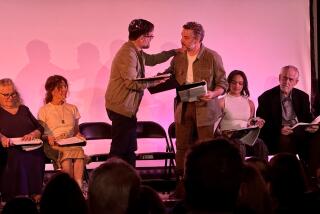STAGE REVIEW : L.A. Events Give Play Extra Impact
NATIONAL CITY — Some said the jury’s verdict was racially motivated. Reactions to the case prompted violence, a “mob mentality,” distrust of the legal system. The defendant’s name wasn’t Rodney King; it was Tom Robinson, and his fictitious trial took place in 1935. The stage adaptation of the novel, “To Kill a Mockingbird,” resonates more forcefully than anyone at Lamb’s Players Theatre could have imagined.
Tom, a black hired hand, has been accused of raping a white woman. Atticus Finch has agreed to defend him. That doesn’t sit well with most white folks in Maycomb. Atticus and his family are subjected to all kinds of abuse. The verdict is inevitable. But this is not a story about winning; it’s about Atticus’ fierce loyalty to conscience, integrity and fairness in the face of ignorance and bigotry.
It’s impossible to sit through the trial in the play without the televised images of the past few days exploding in your head. It’s difficult not to wince when young Jem Finch asks how the jury could have reached their decision--in this case to convict an innocent black man. His father, Atticus, replies: “I don’t know how, but they did it. They’ve done it before and they did it today and they’ll do it again.”
“Mockingbird” was the first and only novel of Harper Lee, but it won her a Pulitzer Prize in 1960. When Horton Foote wrote the screenplay two years later, Lee called the adaptation “a work of such quiet and unobtrusive excellence that. . .(it) should be studied as a classic.” She would probably not have said the same about Christopher Sergel’s play.
The dialogue is true to the novel, but as theater, it is too talky and lacks forward-moving action. And the conceit of the novel--the use of a narrator looking back on her childhood years through the eyes of the child--becomes cumbersome and intrusive onstage. The book moves gracefully between the narrative of older Jean Louise, and the perspective of young Scout (Jean Louise at age 9). In the Oscar-winning film version, we never see Jean Louise; we only hear her voice. But onstage, Scout and Jean Louise fairly bump into each other as one describes events and the other enacts them.
There are some clever contrivances in Sergel’s stage version, such as Jean Louise taking on the persona of cantankerous old Mrs. Dubose, a busybody neighbor. The piece sets up expectations as a memory play, but only delivers as a courtroom drama. And although the drama is sometimes powerful, it comes with more than a touch of sentimentality and sermonizing.
The play packs a punch when it holds a disconcerting mirror up to American intolerance. Unfortunately, recent events show that not much has changed; America’s past is America’s present.
In the Lamb’s production, things meander along in act one, more because of excess exposition and insufficient action than as a reflection of the lazy pace of 1930s Alabama. The dramatic tension increases significantly in act two, when the trial really gets under way.
David Cochran Heath gives just the right touch of gentle humility to Atticus. The three children--Heath’s daughter Carrie as Scout, Jason Russell as Jem and Jedediah Larson as their friend, Dill--convey a strong sense of character; all three are charming and endearing.
Other standouts in the 16-member cast are Grandison Phelps as an innocent, affable Tom; Cynthia Peters as the low-class, fiery Mayella, Tom’s supposed victim; Carmen Beaubeaux as Maudie Atkinson, a liberal-minded Atticus-admirer; and Richard Tibbitts, who plays a critical role and a haunting flute. Pat DiMeo gives a stately wistfulness to Jean Louise. As the villain of the piece, Paul Eggington is loutish enough to be Mayella’s crude and abusive father, but not sufficiently menacing.
Lamb’s artistic director Robert Smyth’s staging is confident, if a bit self-conscious. His lighting design, too, is assured, if not inspired. But he knows how to mine a dramatic moment.
Guest designer Ocie Robinson seems to be less comfortable in the Lamb’s theater. His angular, polished-wood platforms furnish a multileveled playing space, but do not enhance the play. They are appropriate to the courtroom scenes but unmodified for the outdoor locales. There is one provocative element: a long, dangling rope that proves to be a child’s swing, but looks eerily like a noose. Unlike Veronica Murphy Smith’s evocative costumes, the set gives little feel for the South, and a sense of place is crucial to this piece.
On second thought, maybe not. This timely, moving production of “To Kill a Mockingbird” shows us just how mortifyingly American the story is, independent of date or place.
“TO KILL A MOCKINGBIRD”
By Harper Lee. Adapted for the stage by Christopher Sergel. Directed by Robert Smyth. Scenic design by Ocie Robinson. Costumes by Veronica Murphy Smith. Lighting design by Robert Smyth. Stage manager is Barbara Smith. With Carmen Beaubeaux, Pat DiMeo, Paul Eggington, George Flint, Kathi Gibbs, David Cochran Heath, Carrie Heath, Jedediah Larson, Wendaell Lucas, Dean Moore, Cynthia Peters, Grandison Phelps, Jason Russell, Tom Stephenson, Richard Tibbitts, Tim West. Tickets are $15-19. Performances are at 8 p.m. Fridays and Saturdays, 7:30 p.m. Wednesdays and Thursdays, 2 p.m. Saturdays and Sundays, through May 30. At Lamb’s Players Theatre, 500 Plaza Boulevard, National City. Call 474-4542.
More to Read
The biggest entertainment stories
Get our big stories about Hollywood, film, television, music, arts, culture and more right in your inbox as soon as they publish.
You may occasionally receive promotional content from the Los Angeles Times.










